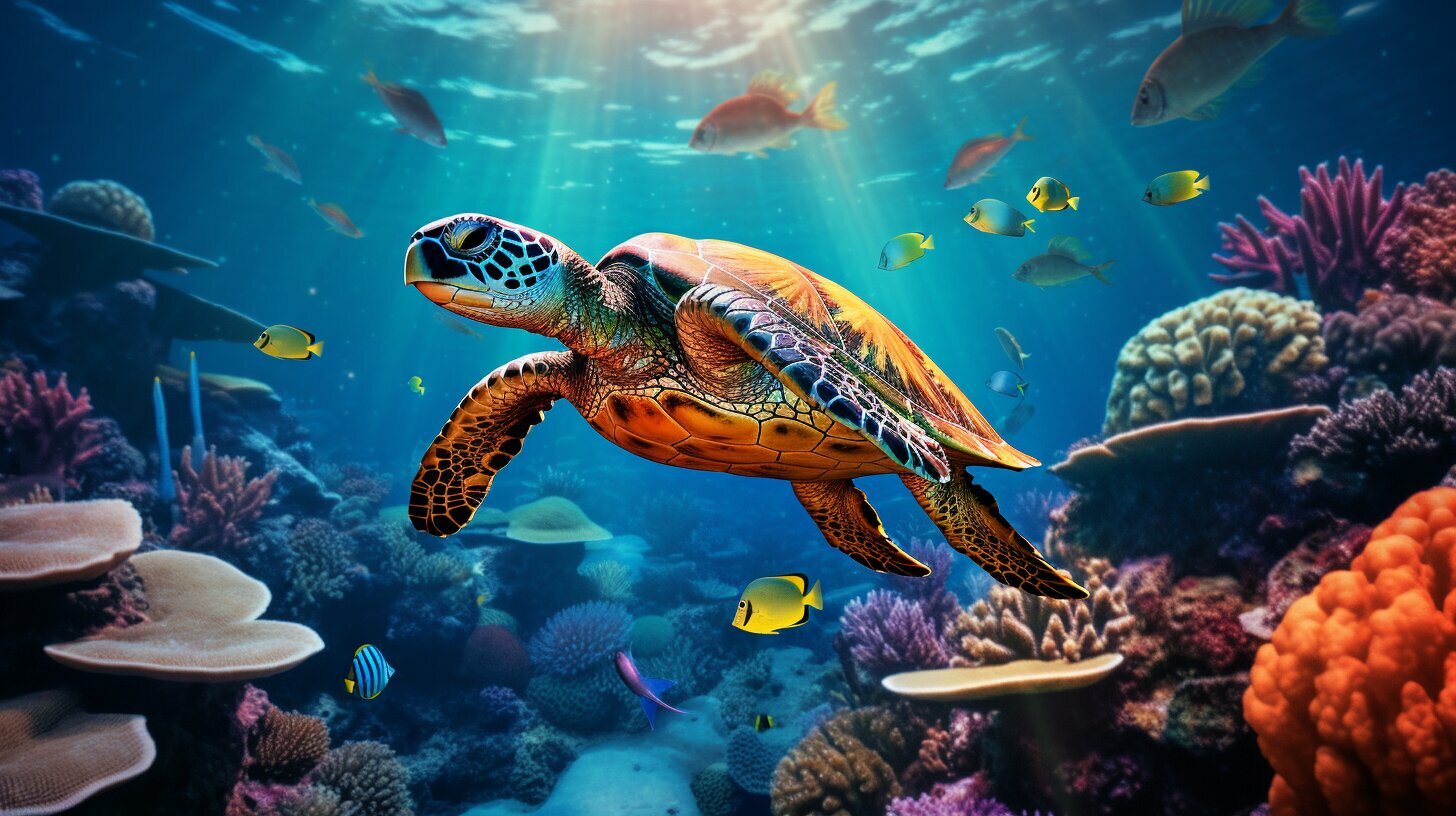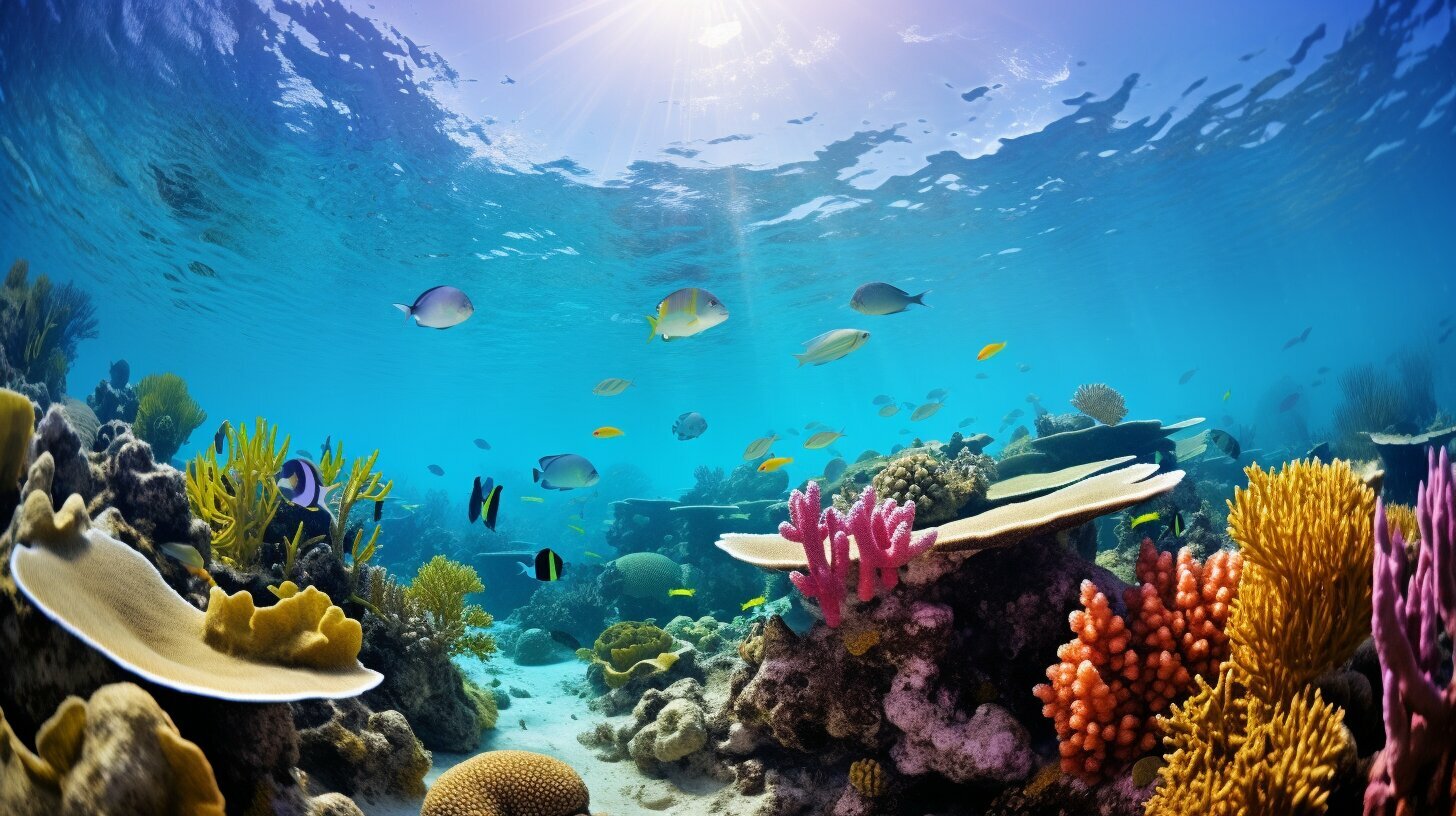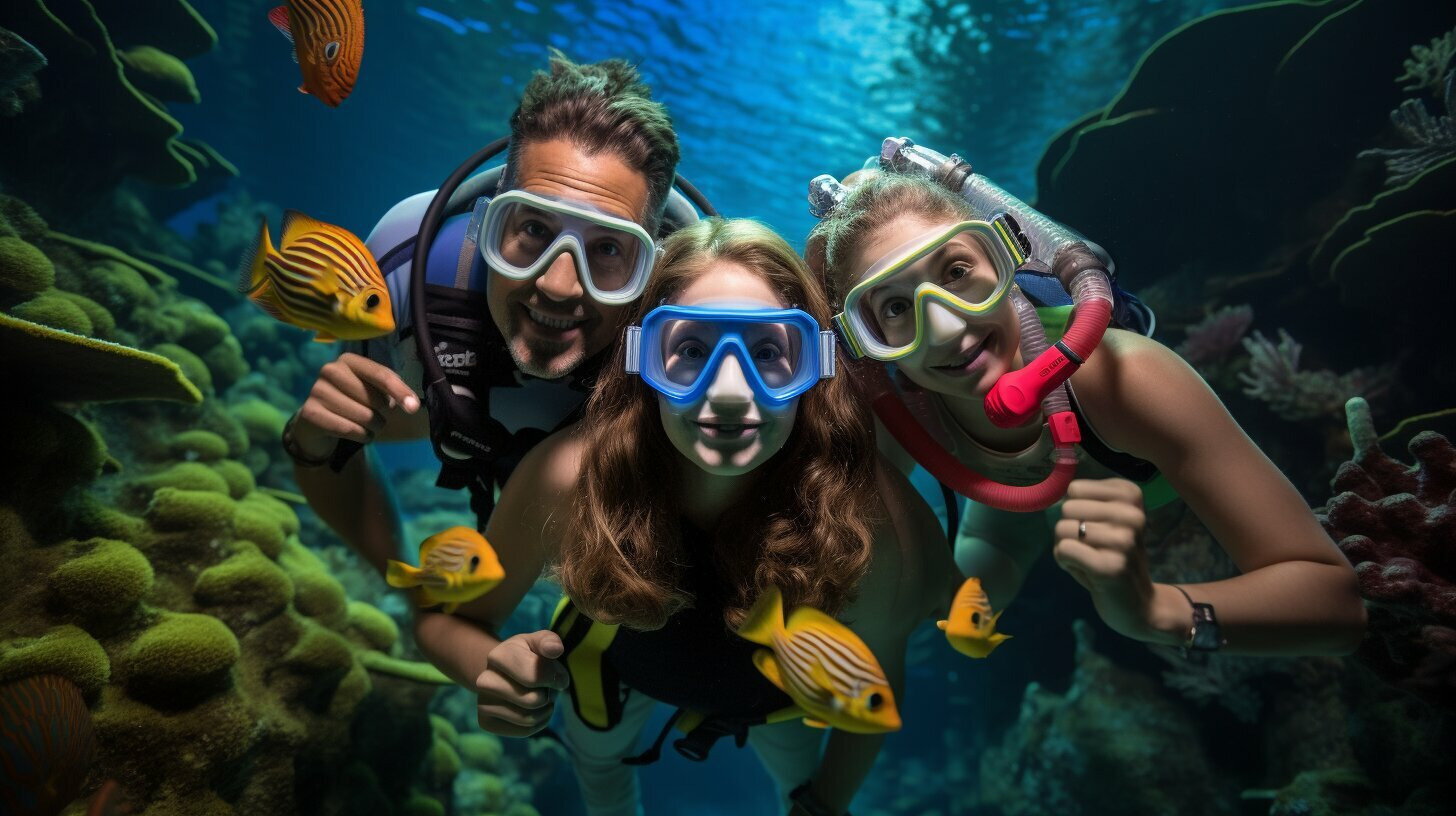If you’re looking for a new adventure in the water, snorkeling is an excellent choice. It’s a fun and exciting way to explore the underwater world and experience the beauty of marine life up close. But if you’re new to snorkeling, it can be intimidating to get started. Where do you begin? What equipment do you need? How do you stay safe in the water?
Don’t worry; we’ve got you covered. Our comprehensive guide to snorkeling for beginners will provide you with all the essential tips and tricks to help you navigate your underwater journey with confidence and ease. Whether you’re a first-time snorkeler or looking to brush up on your skills, this guide is perfect for you.
Key Takeaways
- Snorkeling is a fun and exciting way to explore the underwater world.
- Choosing the right equipment is crucial for an enjoyable and safe snorkeling experience.
- Practicing proper snorkeling techniques and safety measures will ensure a successful adventure.
Getting Started with Snorkeling
If you’re a beginner at snorkeling, it’s important to start with the basics. Before you jump into the water and start exploring, there are a few things you need to know to ensure a successful and enjoyable experience. Follow these steps to get started:
- Choose the right location: Look for calm, clear waters with little to no currents. It’s best to start in shallow water, where you can stand and practice breathing through your snorkel.
- Select the right snorkeling gear: Choose a snorkeling mask that fits snugly on your face and has a silicone skirt that creates a seal around your eyes and nose. Your snorkel should be comfortable in your mouth and have a purge valve to clear any water that may enter. Fins are optional but can help improve your maneuverability in the water.
- Practice breathing through your snorkel: Before you get in the water, practice breathing through your snorkel on land. Inhale and exhale slowly and deeply, and make sure you can breathe comfortably through your mouth. Remember to keep your tongue at the bottom of your mouth and your lips sealed around the mouthpiece to prevent leaks.
- Get comfortable with your gear: Once in the water, take a few moments to adjust your gear and get comfortable breathing through your snorkel. Submerge your face in the water, inhale through your snorkel, and exhale through your nose to clear any water that may have entered your mask.
- Start exploring: Once you’re comfortable with your gear, start exploring the underwater world. Use your fins to propel yourself through the water and adjust your breathing to match the pace of your movements. Always keep an eye on your surroundings and practice snorkeling techniques such as clearing your mask and equalizing your ears.
With these basic steps, you’ll be well on your way to enjoying a successful first snorkeling experience. Remember to take it slow, practice, and most importantly, have fun!
Disclosure: When you buy through links on our site, we may earn an affiliate commission.
Choosing the Right Snorkeling Equipment
Having the proper snorkeling equipment is essential for a comfortable and safe experience in the water. As a beginner, you might feel overwhelmed by the wide range of snorkeling gear available in the market. Below are the essential snorkeling equipment for beginners:
| Equipment | Description |
|---|---|
| Masks | A snug-fitting mask with a silicone skirt that covers your nose and eyes, which allows you to see clearly underwater. |
| Snorkel | A J-shaped tube that allows you to breathe without lifting your head out of the water. It’s best to choose a snorkel with a purge valve that enables you to clear water easily. |
| Fins | Short or long flippers for your feet that provide propulsion and help you swim with less effort. Look for snug-fitting fins that don’t cause blisters or cramps. |
| Wetsuits | Optional but recommended if you plan to snorkel for an extended period or in cold water. It keeps you warm and protects your skin against jellyfish stings or scratches from rocks or corals. |
When choosing your equipment, consider your comfort, fit, and quality. Don’t skimp on the quality of your gear, as it can make a significant difference in your overall experience. If possible, try on different masks and fins to ensure they fit correctly and feel comfortable.
Investing in high-quality gear might cost more upfront, but it will last longer and provide a better experience, making it worth the investment.
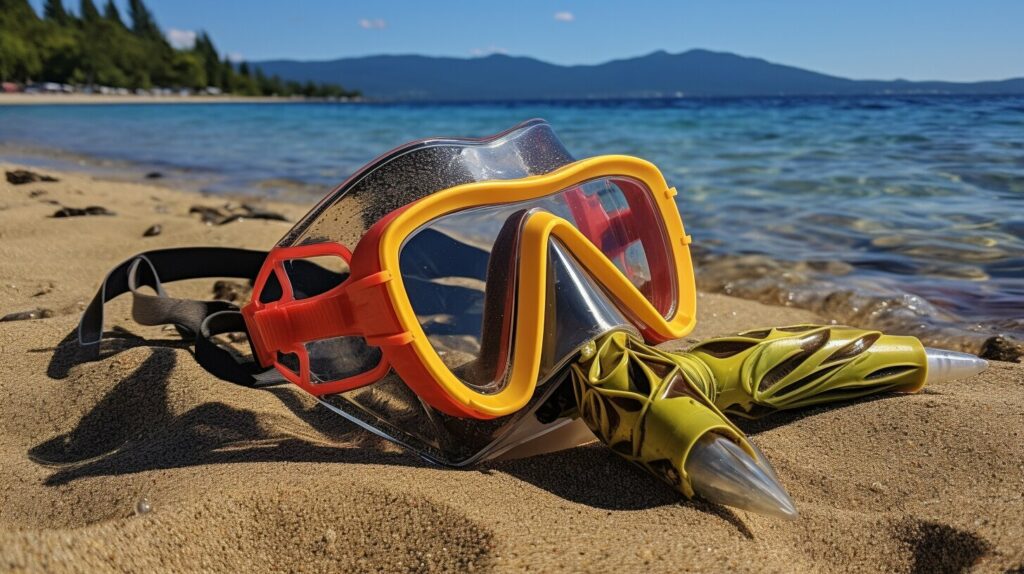
Finding Beginner-Friendly Snorkeling Spots
Not all snorkeling spots are created equal, and it’s important to find a location suitable for your skill level. As a beginner, you’ll want to find calm waters with clear visibility to help build your confidence. Here are some of the best beginner-friendly snorkeling destinations for your next adventure:
| Destination | Location | Features |
|---|---|---|
| Key Largo | Florida | Crystal clear waters, shallow reefs, and an abundance of tropical fish |
| Kapalua Bay | Hawaii | Protected bay with calm waters and an array of marine life, including sea turtles |
| Catalina Island | California | Clear waters, kelp forests, and underwater caves to explore |
| Cozumel | Mexico | Crystal clear waters, abundant marine life, and vibrant coral reefs |
Remember to always research the location’s current conditions, including water temperature, visibility, and current strength, before heading out. Additionally, be sure to follow any local rules and regulations to preserve the fragile marine ecosystem and ensure a safe snorkeling experience.
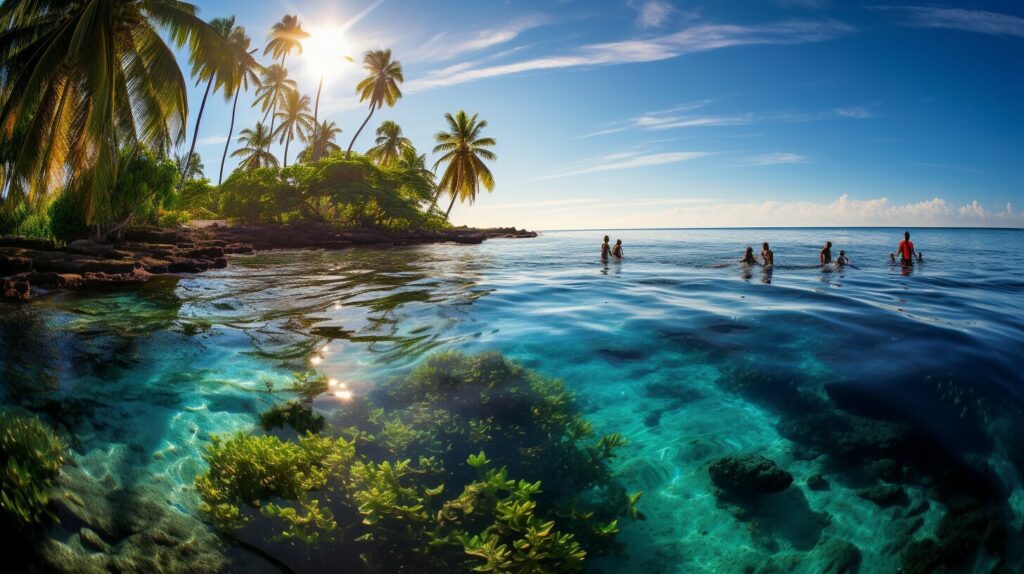
Safety Tips for Beginner Snorkelers
Snorkeling can be a fun and exciting experience for beginners, but it’s important to prioritize safety. Here are some essential snorkeling techniques to keep in mind:
1. Breathing Techniques
Before you start snorkeling, practice your breathing technique. Breathe calmly and deeply through your mouth using the snorkel tube. Make sure to exhale fully to clear the tube of any water that may have entered.
2. Equalizing Your Ears
As you descend into the water, the pressure around your eardrums increases. To equalize the pressure, pinch your nose with your fingers and gently blow through your nose.
3. Body Positioning
Keep your body in a horizontal position while snorkeling. This reduces drag and helps you move smoothly through the water. Avoid flailing your arms or legs, as this can disturb marine life and waste your energy.
4. Maintaining Awareness
Always be aware of your surroundings and the marine life around you. Keep a safe distance from any potentially dangerous creatures, such as jellyfish or stingrays. Avoid touching or standing on coral reefs, as this can cause damage to the delicate ecosystem.
5. Surface Regularly
Take frequent breaks to surface and catch your breath. This not only helps you conserve energy but also allows you to regularly check your location and surroundings.
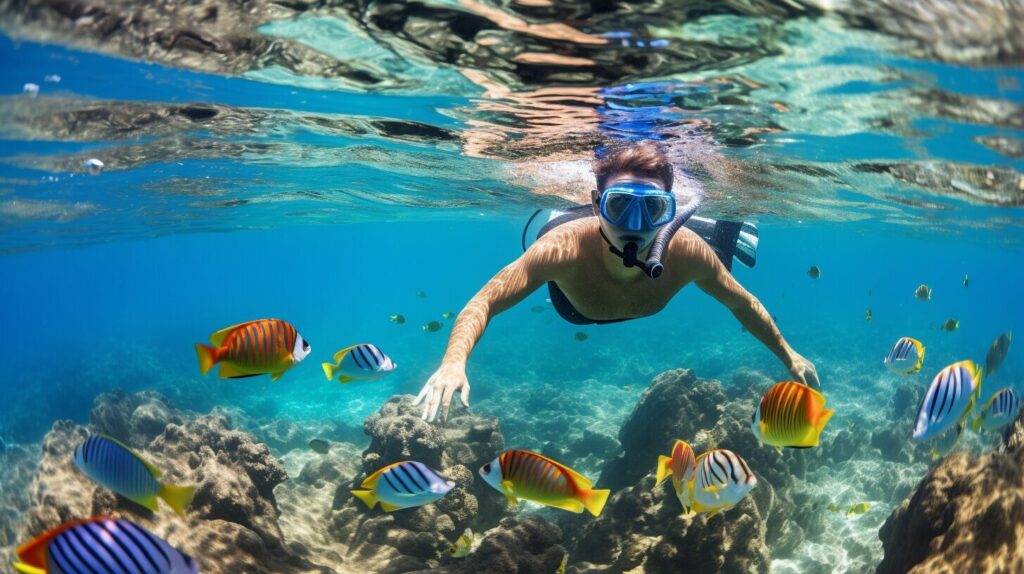
By following these safety tips and techniques, you can fully enjoy your snorkeling adventure as a beginner. Remember to take it slow, stay aware, and have fun exploring the underwater world.
Mastering Snorkeling Techniques
Snorkeling is an exciting adventure that requires basic techniques to make the most out of your underwater experience. In this section, we’ll cover essential snorkeling techniques for beginners.
Clearing your mask: It’s common for masks to fog up or take in water while snorkeling, but don’t worry! Here’s how to clear your mask:
- Look up towards the surface, pressing the top of your mask against your forehead.
- Exhale forcefully through your nose while simultaneously lifting the bottom edge of the mask away from your face.
- The water will be pushed out of the bottom of the mask, and you can reseal it against your face.
Equalizing your ears: As you descend into the water, pressure around your ears will increase. Here’s how to equalize your ears:
- Pinch your nose closed with your fingers.
- Gently exhale while keeping your mouth closed.
- You’ll feel a sensation of equalizing pressure, and the discomfort will disappear.
Effective fin kicks: Fins are essential for propulsion and maintaining balance while snorkeling. Use these techniques to maximize your fin kicks:
- Keep your fins relaxed and use ankle movements to propel yourself forward.
- Use long, slow strokes rather than rapid, jerky ones.
- Practice different fin kicks to find the most comfortable and efficient technique for you.
Incorporating these techniques into your snorkeling adventure will enhance your underwater experience and give you the confidence to explore new depths. Happy snorkeling!
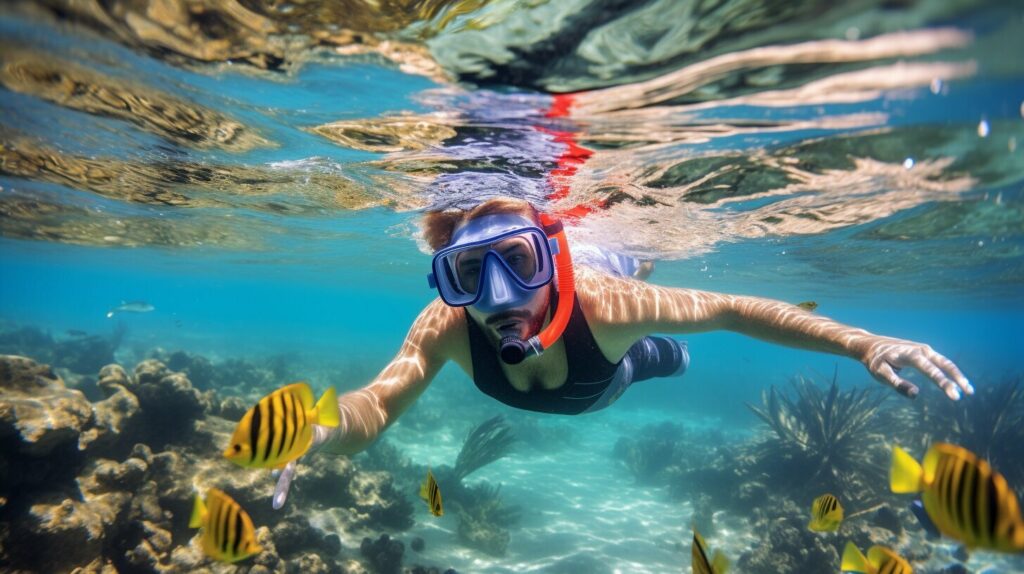
Enhancing Your Snorkeling Experience
Snorkeling is not just about observing marine life, it’s also about enhancing your overall experience. Here are some tips to make the most of your snorkeling adventure:
- Practice mindfulness: Take a moment to appreciate the beauty of your surroundings. Focus on your breathing and the sensation of floating on the water.
- Choose the right time of day: Snorkeling during midday when the sun is high can cause harsh glare and make it difficult to see. Try snorkeling in the morning or late afternoon when the light is softer and the marine life is more active.
- Experiment with different techniques: Don’t be afraid to try out different swimming techniques or snorkeling styles to find what works best for you.
- Stay hydrated: It’s easy to lose track of time when snorkeling, but it’s important to stay hydrated, especially in warm weather.
By following these beginner snorkeling tips, you can enhance your experience and create unforgettable memories.

Exploring Underwater Wildlife
One of the most thrilling aspects of snorkeling is encountering fascinating marine life. From vibrant schools of fish to majestic sea turtles, the underwater world is full of incredible creatures waiting to be discovered.
When exploring underwater wildlife, it’s crucial to be mindful of your surroundings and the animals you encounter. Remember to keep a safe distance from marine life and avoid touching or disturbing them. It’s best to observe them from a distance and let them go about their natural behaviors.
Here are some tips for identifying common marine species:
| Marine Species | Description |
|---|---|
| Sea turtles | Large, slow-moving reptiles with distinctive shells and flippers. |
| Tropical fish | Colorful and diverse fish found in warm waters. |
| Stingrays | Flat-bodied fish with long tails and venomous barbs. |
| Moray eels | Slender, snake-like fish with sharp teeth and excellent hiding abilities. |
It’s vital to observe marine life responsibly to protect their habitats and ensure their safety. Here are some tips for responsible wildlife interaction:
- Do not touch or chase marine life.
- Avoid disturbing their natural habitats and behaviors.
- Do not feed marine life, as it can disrupt their natural diet and feeding habits.
- Avoid using flash photography, as it can harm or disorient marine life.
To make the most of your wildlife encounters, consider investing in an underwater camera to capture and document your snorkeling adventure.
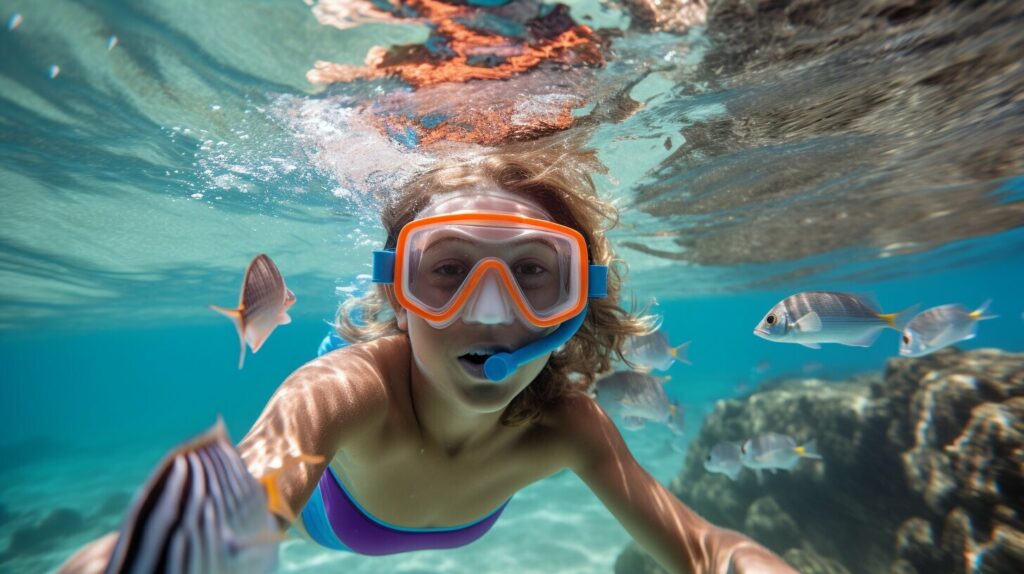
Dealing with Common Challenges
As a beginner snorkeler, you will encounter some common challenges that can affect your experience in the water. But don’t let these obstacles discourage you! With a bit of preparation and the right tips, you can overcome these challenges and have a successful snorkeling adventure.
Water Entry and Exit
Getting in and out of the water can be tricky, especially if you’re snorkeling at a rocky beach or in choppy waters. To make the process easier, it’s essential to know the correct techniques.
When entering the water, put on your fins before you’re in too deep. Walk backward towards the water while keeping your mask in place, and your snorkel in your mouth. Once you’re knee-deep, turn around and put your face in the water while keeping your feet on the ground. Begin swimming once you’ve situated yourself in waist-deep water.
When exiting the water, swim to shore and stand up in waist-deep water. Remove your fins and walk backward out of the water, keeping your mask in place.
Foggy Masks
One of the most common challenges when snorkeling is a foggy mask. A foggy mask can make it challenging to see underwater, which can be dangerous.
To prevent fogging, apply a defogging solution to your mask, or opt for a mask that has an anti-fog coating. Additionally, make sure your mask is fitting correctly, with no gaps for water to seep in.
Tip: When there is no defogging solution available, lick your fingers and rub them on the inside of the mask.
Water Currents
Strong water currents can be dangerous, even for experienced snorkelers. As a beginner, it’s essential to be aware of water currents and to avoid snorkeling in areas with strong currents.
If you find yourself caught in a current, do not panic. Swim parallel to the shore until you’ve escaped the current’s pull, then swim back to shore. If you can’t swim out of the current, remove your fins and raise your hand to signal for help.
 Beginner Snorkeling Tips:
Beginner Snorkeling Tips:
- Practice snorkeling in calm and shallow water before attempting deeper waters.
- Breathe slowly and deeply while snorkeling. Shallow breathing can cause anxiety and fatigue.
- Stay aware of your surroundings and always keep an eye on other snorkelers in your group.
- Don’t touch or harass marine life. Maintain a safe distance to avoid causing harm or injury to the creatures you encounter.
With these tips and tricks, you’ll be well-equipped to deal with common snorkeling challenges and have a safe and enjoyable experience underwater. Remember to stay calm and focused, and don’t hesitate to seek help if you need it. Happy snorkeling!
Snorkeling Etiquette and Environmental Responsibility
Snorkeling is not just about personal enjoyment; it’s also about respecting the marine environment. As a beginner snorkeler, it’s important to understand and follow snorkeling etiquette to help protect the delicate marine ecosystem.
Here are some tips on how to be a responsible snorkeler:
- Avoid touching or standing on coral reefs. They are living organisms that can be easily damaged or killed.
- Do not chase or harass marine life. Observe them from a distance, and keep a safe distance away from animals that may feel threatened by your presence.
- Dispose of all trash properly. Bring a reusable water bottle and take all trash back with you to shore, including biodegradable items such as fruit peels.
- Don’t feed the fish. Feeding fish can cause them to become dependent on humans and disrupt their natural behavior and diet.
Additionally, here are some general beginner snorkeling tips to keep in mind:
- Don’t touch anything underwater. Even seemingly harmless creatures like sea urchins can be dangerous if touched.
- Stay aware of your surroundings. Be mindful of boats, other snorkelers, and potential hazards in the water.
- Always snorkel with a buddy. Having a partner increases safety and makes the experience more enjoyable.
- Practice good buoyancy control. Avoid touching the bottom or stirring up sediment, as this can harm the marine environment and reduce visibility.
By following these tips and being a responsible snorkeler, you’ll not only protect the marine environment but also have a more enjoyable and fulfilling snorkeling experience.
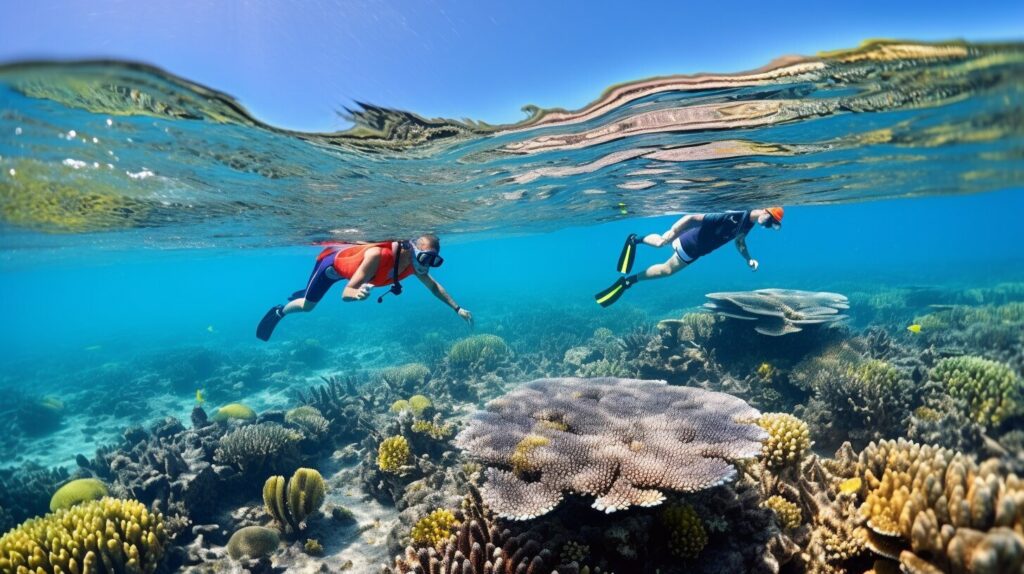
Snorkeling Safety Precautions and Emergency Preparedness
While snorkeling is a relatively safe activity, it’s important to take the necessary precautions to ensure your safety in the water. Here are some tips for staying safe while snorkeling:
Invest in Quality Snorkeling Equipment
Having the right equipment is crucial for a safe and comfortable snorkeling experience. As a beginner, it’s important to invest in quality snorkeling gear that fits properly and is appropriate for your skill level. Make sure to choose a well-fitting mask that covers your nose and seals tightly around your face, a snorkel with a comfortable mouthpiece, and fins that fit snugly but not too tightly.
It’s also a good idea to wear a wetsuit or rash guard to protect your skin from the sun and to keep you warm in colder waters. When choosing a wetsuit, select one that is the right thickness for the water temperature and is comfortable and easy to move in.
Be Aware of Your Surroundings
Before entering the water, take a few moments to observe your surroundings and identify any potential hazards. Look out for sharp rocks, strong currents, or areas with a high concentration of jellyfish or other dangerous sea creatures.
It’s also important to stay aware of your surroundings while snorkeling. Keep an eye on your fellow snorkelers and any boats or other watercraft in the area. Avoid snorkeling alone and always stay within a reasonable distance of your group or guide.
Practice Safe Snorkeling Techniques
Proper snorkeling techniques can also contribute to your safety in the water. Make sure to breathe regularly and deeply through your mouth while keeping your snorkel tube above the water. Clear your snorkel regularly to prevent water from entering it, and use your fins to move efficiently through the water while avoiding contact with the seabed or coral reefs.
If you feel uncomfortable or experience any issues while snorkeling, signal to your guide or fellow snorkelers and exit the water immediately.
Be Prepared for Emergencies
Even with proper precautions, emergencies can still happen while snorkeling. It’s important to be prepared for any potential risks or incidents.
Before entering the water, make sure you know the location of any nearby medical facilities or emergency services. Bring a first aid kit and make sure to familiarize yourself with its contents. If you have any pre-existing medical conditions, make sure to inform your guide or group beforehand.
In case of an emergency, signal for help immediately and follow the instructions of your guide or fellow snorkelers.
By following these safety precautions and being prepared for emergencies, you can enjoy a safe and enjoyable snorkeling experience. Remember to always prioritize your safety and the safety of those around you while exploring the wonders of the underwater world.
Conclusion
You’re now equipped with the knowledge and tips to embark on a snorkeling adventure as a beginner. Remember to practice, stay safe, and enjoy exploring the magnificent underwater world.
Snorkeling opens up a whole new world of beauty and wonder, and we hope this guide has inspired you to dive in with confidence and make unforgettable memories. Happy snorkeling!
FAQ
Q: What is snorkeling?
A: Snorkeling is a water activity where you swim on the surface of the water with a mask, snorkel, and fins to observe underwater scenery and marine life.
Q: How do I start snorkeling?
A: To start snorkeling, you’ll need to select the right snorkeling gear, familiarize yourself with the basics of snorkeling, and find a suitable snorkeling spot to practice.
Q: What equipment do I need for snorkeling?
A: Essential snorkeling equipment includes a mask, snorkel, fins, and optional extras such as a wetsuit, sunscreen, and a snorkeling vest for added buoyancy.
Q: Where can I find beginner-friendly snorkeling spots?
A: There are many beginner-friendly snorkeling spots around the United States, such as Catalina Island in California, Hanauma Bay in Hawaii, and John Pennekamp Coral Reef State Park in Florida.
Q: What safety precautions should I take while snorkeling?
A: Important safety tips for snorkelers include proper breathing techniques, staying aware of your surroundings, wearing a life jacket if needed, and snorkeling with a buddy.
Q: What are some basic snorkeling techniques?
A: Basic snorkeling techniques include clearing your mask if it gets water inside, equalizing your ears to relieve pressure, and using effective fin kicks to propel yourself through the water.
Q: How can I enhance my snorkeling experience?
A: You can enhance your snorkeling experience by practicing mindfulness, choosing the right time of day for optimal visibility, and learning to spot hidden underwater wildlife.
Q: How do I identify marine species while snorkeling?
A: You can identify marine species while snorkeling by familiarizing yourself with common characteristics of different species, such as body shape, color patterns, and behavior.
Q: What challenges might I face while snorkeling?
A: Common challenges while snorkeling include water entry and exit, dealing with foggy masks, and navigating water currents. We provide practical tips to overcome these challenges in our guide.
Q: How can I be a responsible snorkeler?
A: Being a responsible snorkeler involves respecting marine life by not touching or harassing them, avoiding damage to coral reefs, and properly disposing of any waste.
Q: What safety precautions should I take while snorkeling?
A: Safety precautions for snorkeling include checking weather conditions, wearing appropriate snorkeling gear, staying hydrated, and being prepared for potential risks or emergencies.
Q: Is snorkeling suitable for beginners?
A: Yes, snorkeling is suitable for beginners. With the right equipment, basic techniques, and safety precautions, beginners can enjoy a safe and enjoyable snorkeling experience.

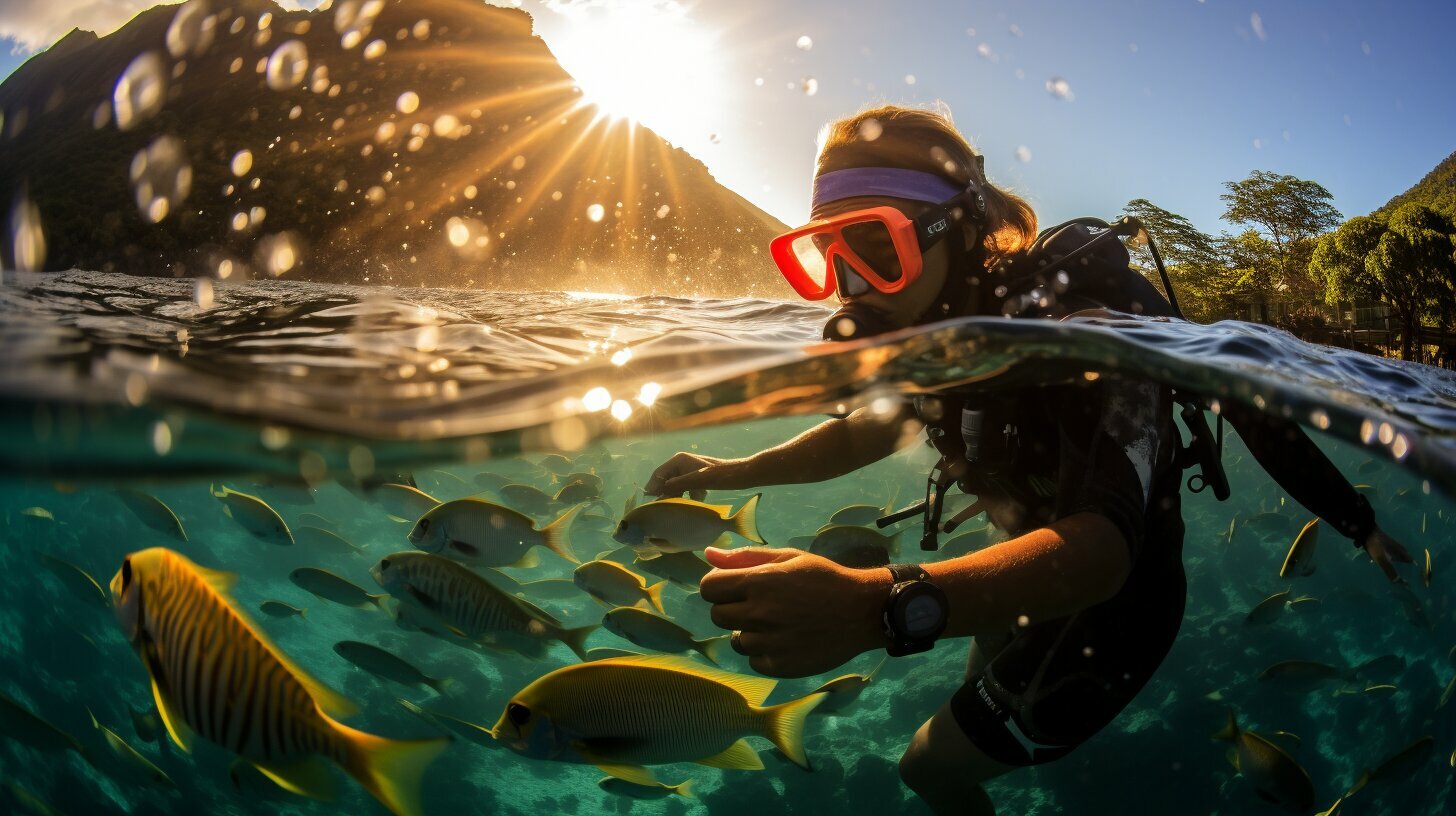
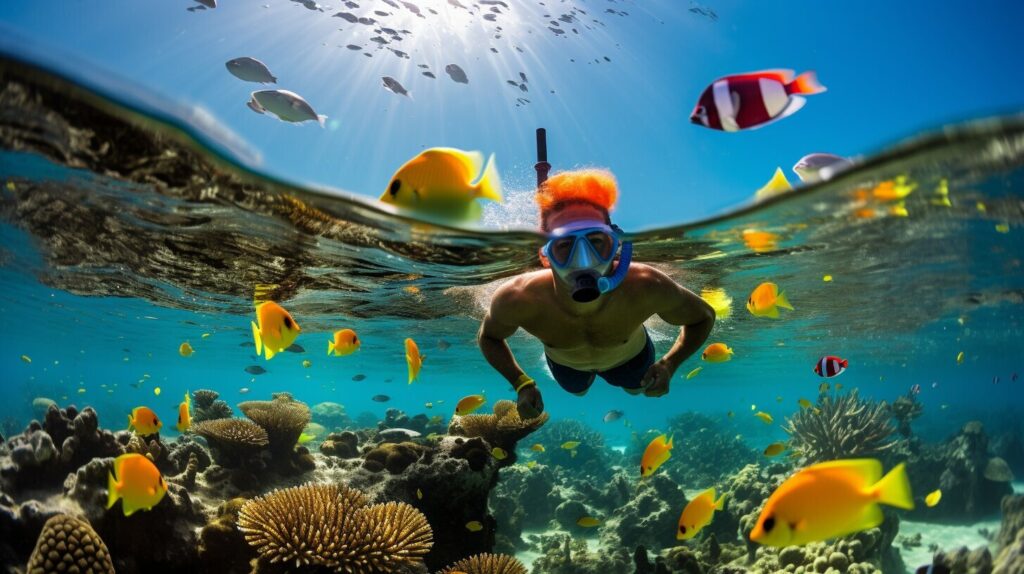 Beginner Snorkeling Tips:
Beginner Snorkeling Tips: